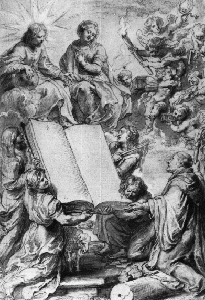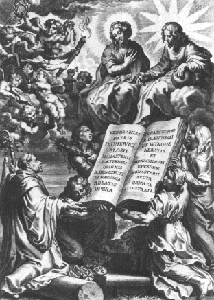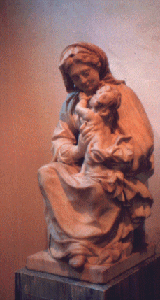Rubens diary, April 2nd 1632, 8 A.M.
My first work today was to finish a drawing for a book which is going to be edited by Balthasar's (Plantin) printing office.
As I often do, I called one of the boys working in the pupils' studio into my room in order to explain him how I make my designs for book-illustration. This time it was Lucas Faid'herbe whom I instructed. He's a clever boy of fifteen and very talented; in a couple of years he will be master and maybe an excellent assistent, though I think he will be a sculptor rather than a painter... (*)The drawing I completed will illustrate the title page of an important book with the collected works of a benedictine monk called Blosius. It's a rather well-filled design.
...


Left: Rubens' drawing
Notice the design was mirrored to the result!
Right: after engraving: the copperplate print
...The author himself sits kneeled in front of a large opened book; on its pages the title will be printed. It is held by four women who are supposed to symbolise the four monastic virtues, described by Blosius in one of his works: mystical contemplation, gentleness of bearing, deep humility and mortification of the flesh. Above Mary and her Son Jesus are looking down upon them.As usual I chose and copied the figures out of a collection of drawings I keep for that purpose; it makes work easier and quicker. Blosius' portrait on the other hand has been sent to me by his Order.
Our engraver Galle was informed the design would soon be ready and came to get it. One of these days he will start making the engraving on copperplate for Moretus.
Notes:

(*) LUCAS FAID'HERBE,born in 1617, became an important baroque sculptor and also an architect; being a young master, Rubens asked him to be the surveyor of his studios in Antwerp, when from 1635 on he retired into his new 'Steen', a small castle in the Brabant-region south of the city.
Rubens was the main illustrator of the Plantin printing office from 1612 on; he made hundreds of designs for books, edited by his good friend Balthasar Moretus, the grandson of Plantin, one of the most famous renaissance typographers.
For the baroque book, a title-page or frontispice with a lot of allegorical figures, was a must. Rubens made many, it was an easy work for him, being most specialised in representing mythological and symbolic figures.
There was an excellent collaboration between Rubens as the designer, engravers such as Cornelis and Theodore Galle, and the printing office.
 (back to the diary)
(back to the diary)
This page hosted by  Get your own Free Home Page
Get your own Free Home Page



 (back to the diary)
(back to the diary)